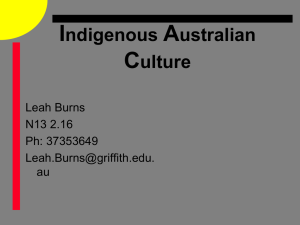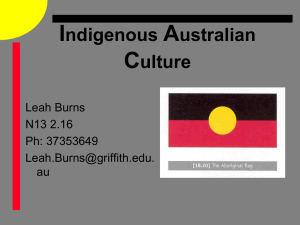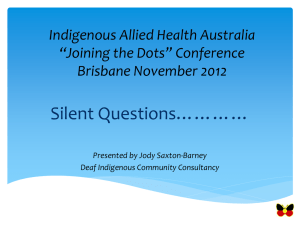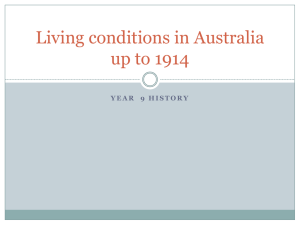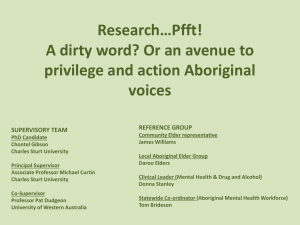NAIDOC Week July 2014
advertisement
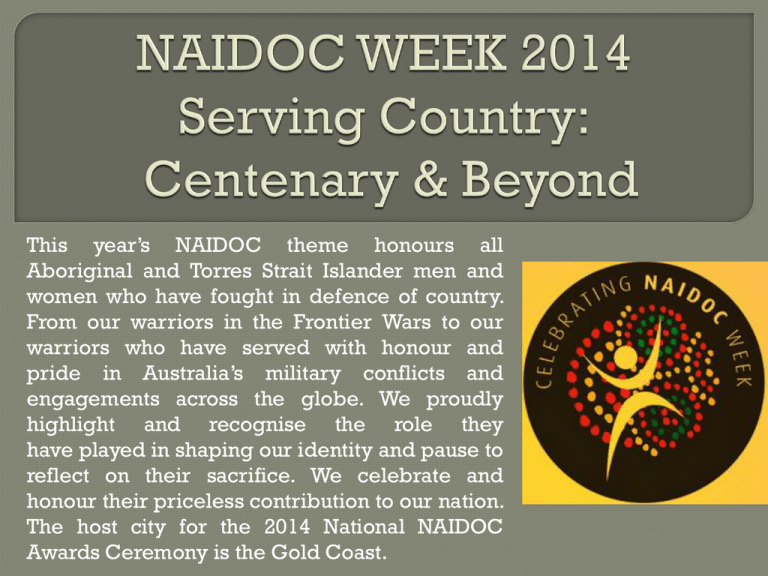
This year’s NAIDOC theme honours all Aboriginal and Torres Strait Islander men and women who have fought in defence of country. From our warriors in the Frontier Wars to our warriors who have served with honour and pride in Australia’s military conflicts and engagements across the globe. We proudly highlight and recognise the role they have played in shaping our identity and pause to reflect on their sacrifice. We celebrate and honour their priceless contribution to our nation. The host city for the 2014 National NAIDOC Awards Ceremony is the Gold Coast. Have fought in every conflict since the start of the 21st century including the Boer War, WW1, WW11, East Timor and probably Afghanistan. Participated in the South African Boer War (1899-1902) as trackers and guides. Were barred from involvement in conflict in the first half of the 20th century but about 500 managed to enlist in WW1. Exact numbers were unknown as ethnicities were not recorded on personnel files. William Stubbings, great-grandson of members of the Boorooberongal clan of the Darug, fought in the Boer War. Were rejected (racial reasons) but around 500 enlisted Slowly changed attitudes within army – fought in all campaigns. Numbers increased due to conscription New order made enlisting easier if 1 parent was of European origin Some this as an opportunity to prove their equality with Europeans or to get better treatment after the war. Reg Saunders was the first aboriginal soldier to be commissioned as an officer in the Australian Army. Just like other Australians many indigenous soldiers became POWs. Private Reginald Francis Hawkins, a station hand from Jericho, QLD, enlisted at the age of 23 on 29 October 1915 and embarked for overseas on 5 June 1916 aboard HMAT Borda. He was hit by a shell in the left leg and right side of the head and captured at Armentieres, France, on 14 February 1917. After being taken prisoner, Private Hawkins was assigned the POW identity number 6.6518 (see uniform). Private Hawkins was held as a POW in various camps in Germany until repatriated to England on 10 January 1919 and Australia on 12 May 1919. The repression of Indigenous Australians increased between wars, as protection acts gave government officials greater control over Indigenous Australians. As late as 1928 Indigenous Australians were massacred in reprisal raids by white Australians. A major Aboriginal political movement in the 1930s achieved little improvement in civil rights. Indigenous Australians like William Cooper, Secretary of the Australian Indigenous Australians’ League, argued that Indigenous Australians should not fight for White Australia. Cooper lost his son in WW1 and was bitter that Aboriginal sacrifice had not improved rights and conditions. Cooper demanded improvements at home before taking up “the privilege of defending the land which was taken from him by the White race without compensation or even kindness”. Political activist William Cooper Greater numbers of indigenous soldiers in WW11 until 1940 when indigenous participation was considered “Neither necessary not desirable” (Defense committee, 1940) Soldiers in the North front lined against Japanese in 1942. Indigenous soldiers received equal pay, promotion on merit and forged strong relationships with white men. Between & following both wars Leonard Waters - first indigenous soldiers treated with same Aboriginal Australian military aviator, and or worse discrimination as before. only one to serve as a fighter pilot in the RAF. Hundreds of Indigenous Australians served in the 2nd AIF and the militia. Many were killed fighting and at least a dozen died as POWs. As in WW1, indigenous Australians served under the same conditions as Whites in most cases, with promises of full citizenship after the war which they didn’t get. However attitudes changed and restrictions based on race were abandoned in 1949. Since then indigenous Australians have served in all conflicts in which Australia has participated. Private Graeme Brown – an indigenous soldier who served in Somalia in 1993. In 1941 the Torres Strait Light Infantry Battalion was formed to defend the strategically-important Torres Strait area. Other Islander units were also created, especially for water transport and as coastal artillery. By 1944 almost every ablebodied male Torres Strait Islander had enlisted but did not get the same rates of pay or conditions as White soldiers. At first their pay was one-third that of regular soldiers. After a two-day "mutiny" in December 1943 this was raised to twothirds. In proportion to population no community in Australia contributed more to the war effort in the Second World War than Aboriginal & Torres Strait War Memorial in Adelaide the Islanders of the Torres Strait. Aboriginal women played an important role with any enlisting in the women’s services or working in war industries. In northern Australia Aboriginal and Islander women worked hard to support isolated RAAF outposts and even helped to salvage crashed aircraft. Poet, artist & educator Oodgeroo Noonuccal (Kath Walker) joined the Australian Women’s Army Service in 1942, after her brothers were captured by the Oodgeroo Noonuccal in her Japanese at the fall of Singapore. army uniform. She was stationed at Chermside. Wartime service gave many Indigenous Australians pride and confidence in demanding their rights. Nevertheless, Indigenous Australians who fought for their country came back to much the same discrimination as before. For example, many were barred from Returned and Services League clubs, except on Anzac Day. Many were not given the right to vote for another 17 years. Private Horace Dalton Service No. 57247 Enlisted: 16 May 1916 11 Light Horse Regiment Dunwich/Caloundra Served in Egypt from 1918-1919 Returned to Australia in 1919 Died: 1956 Buried in an unmarked grave for 56 years at Ipswich Cemetery Official burial on 1 October 2012 at Ipswich. Aboriginal Trooper Horace Dalton fought in WW1 for the freedom of all Australians, even though he didn't enjoy the same rights as white Australians. When he enlisted in the army at 19, Horace Dalton lied to satisfy the requirement that service people be of "substantially European" origin. Horace had to go through a strict process to be admitted into the defence force. He signed an affidavit saying he had the right heritage to be an Australian soldier even though he was one of the true owners of the land. When Horace returned from the war, he wasn't allowed to attend reunions and when he passed away there was no no military funeral. When the war veteran died in 1956, he was buried in an unmarked grave in the Ipswich Cemetery. Trooper Dalton's son Ken said he was proud of his father's military service, and grateful it was finally recognised with the official burial at Ipswich Cemetery on October 1 2012. Ken was only 16 when Horace died and said his father felt a duty to defend Australia. "Dad fought for the rights of Australians, even though he didn't have them himself," he said. "He signed up, even though his country treated him shamefully”.
